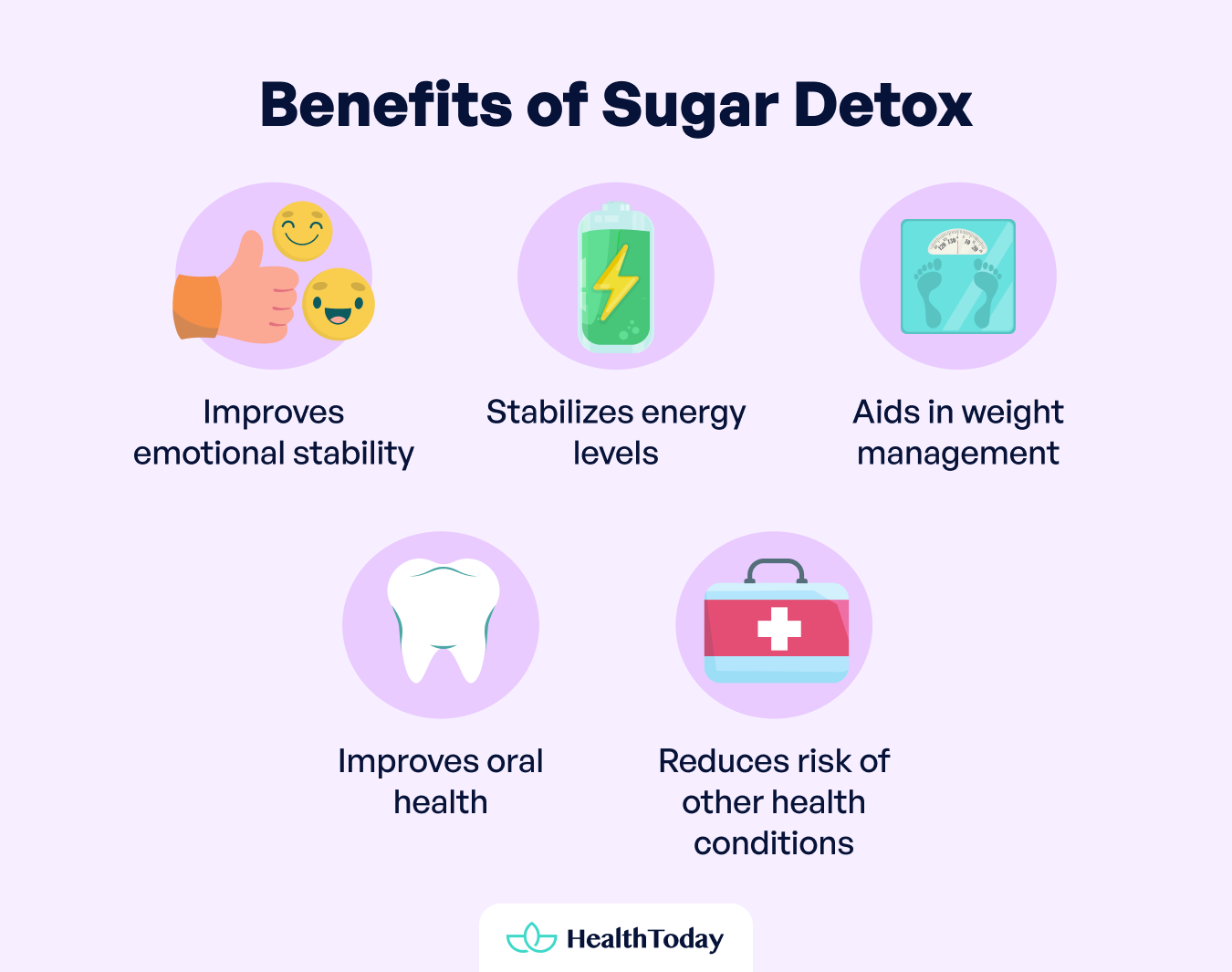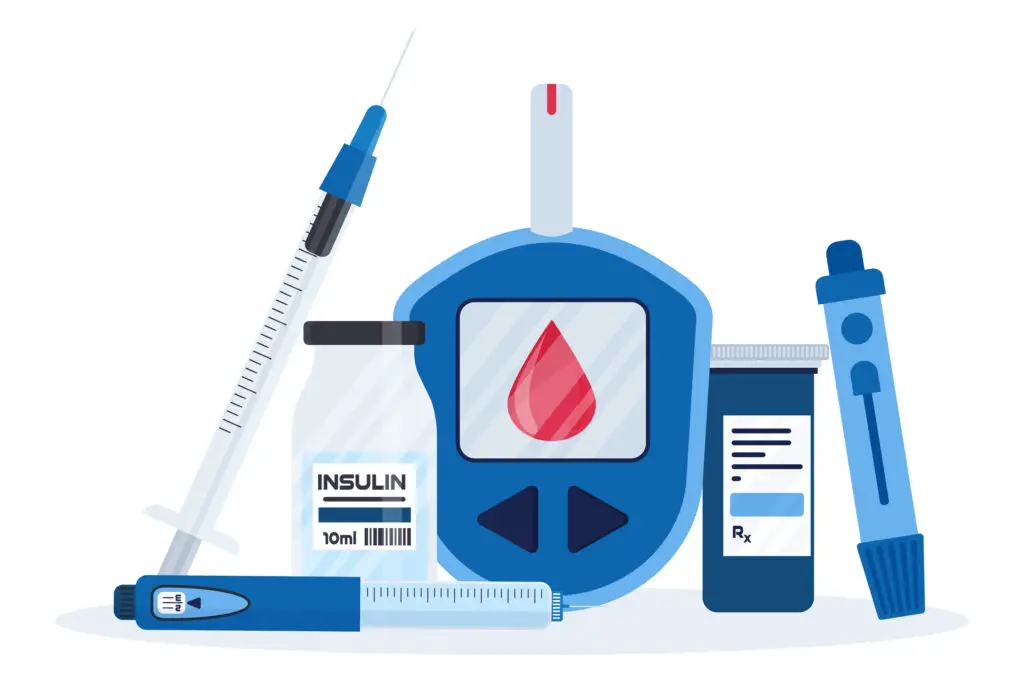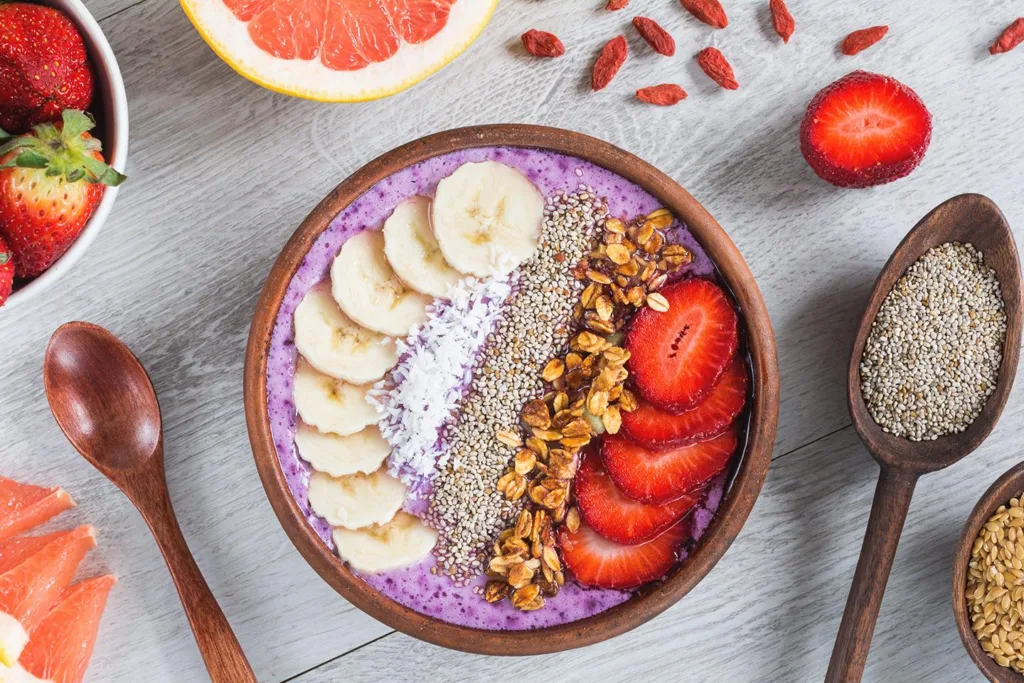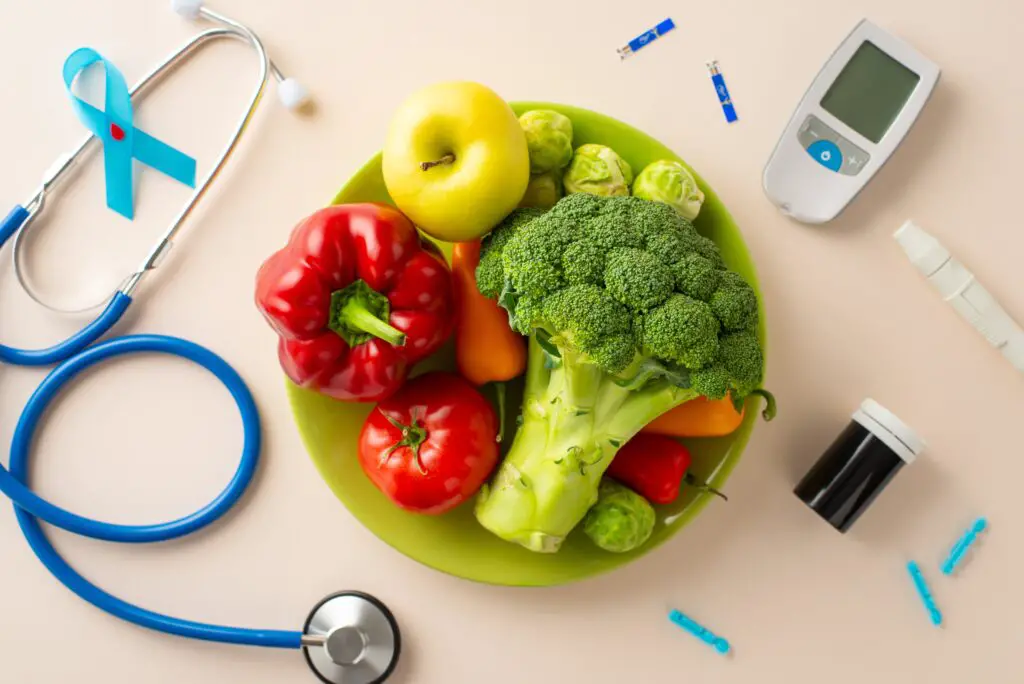Table of Contents
Do you ever feel like you need your morning Starbucks Frappuccino to get through the day? Or those doughnuts at lunchtime to energize you in the afternoon? If you go without your typical sweets and notice that you begin to feel down, have low energy, or develop intense cravings, you may be experiencing sugar withdrawal. This is a telltale sign of sugar addiction, a phenomenon that occurs due to sugar’s effects on the reward systems of the brain (1).
Like in any addiction, you can develop tolerance to sugar. This means that your body gets used to having a steady supply of sugar to keep you feeling ‘normal.’ Without your usual sweets, you feel ‘off,’ both physically and mentally.
If this sounds like you, a sugar detox may be beneficial. During your sugar detox, you significantly reduce your sugar consumption to allow your body to recover from its dependence on sugar. Read on to discover what a sugar detox can do for you and how you can get started.
Basics of how to detox sugar from your body
In your sugar detox, you want to avoid as many added sugars (refined sugars) as possible. Refined sugars are those that do not occur naturally in whole foods but have been extracted and processed by humans before being added to drinks and foods. For instance, added sugars are found in many packaged desserts and sugary beverages. Research shows that added sugars, not natural sugars, are primarily responsible for the health problems associated with ‘sugar’ intake (2).
Getting started with a sugar detox
There are different philosophies regarding how to start a sugar detox. Some nutritionists recommend a ‘cold turkey’ approach, whereby all sugars are cut immediately from the diet. Others recommend a gradual taper, where a little bit of sugar is removed from the diet day-by-day. Everyone is different, so the approach that works best for one person may not be ideal for another. The most important thing is choosing a plan you can stick with.
To get started with a sugar detox, Samantha Cassetty, MS, RD recommends three simple yet effective steps.
- Identify your sugar culprits. Go through your pantry and kitchen and determine which foods and drinks have added sugars. Sometimes, they are obvious (you don’t need to look at the nutritional label to know that a cookie or brownie is a repository of added sugars). Other times, you may need to read the nutritional label. Get rid of—or stash away somewhere you won’t be tempted to access—all of the foods and drinks that contain lots of added sugar.
- Read nutritional labels. Jump straight to the ‘added sugars’ section and avoid the ones with lots of added sugars. Beware of sugars present in small amounts in sauces and condiments, which can quickly add up. The American Heart Association recommends that men consume no more than 36 grams (150 calories) of added sugars per day and that women consume fewer than 25 grams (100 calories) of added sugars per day (3). Know that one 12-ounce can of soda already contains 32 grams of added sugars per day—your entire day’s allotment!
- Trick your taste buds. Cassetty recommends using ‘flavor-boosters’ to fool your taste buds into thinking you’ve had something sweet without actually eating added sugar. Examples include spices, vanilla extract, unsweetened coconut flakes, and real fruit.

Foods that help with a sugar detox
As you remove added sugars from your diet, you’ll want to replace them with something else. Here are some examples of foods that can be a helpful substitute for you as you abstain from added sugars:
- Healthy fats: avocado, nuts, seeds, olive oil, unsweetened coconut. Fats have the highest energy per gram and can keep you feeling satiated.
- Lean proteins: chicken, fish, eggs, Greek yogurt. Proteins keep you feeling full and satisfied to reduce sugar cravings.
- Whole fruits (especially low-sugar varieties): berries, green apples, oranges, grapefruit, kiwis. Try to avoid high-sugar fruits like bananas, grapes, watermelon, and mangoes.
- Starchy vegetables: leafy greens, broccoli, cauliflower, peppers, cucumbers. Starchy vegetables are low in calories and high in fiber, which can keep you feeling full.
- Whole grains: quinoa, brown rice, oats, and barley. These are also high in fiber.
- Spices: cinnamon, cardamom, nutmeg, ginger, cloves. Use these to add some flavor to bland-tasting foods.
- Tea: green, oolong, peppermint, chamomile, fruit-flavored. Swap out sugary beverages for your favorite (unsweetened) teas.
Foods and drinks to avoid with a sugar detox
The following are some examples of the major sources of added sugars that you want to steer clear of:
- Sugary beverages: fruit juices, sodas, energy drinks, sweetened coffee
- Desserts: chocolate, cookies, brownies, ice cream
- Refined carbohydrates: sweetbreads, cake, granola, muffins
- White flour: white bread, white pasta, baked goods made with refined flour
- Sweetened condiments: ketchup, barbecue sauce, teriyaki sauce
- Artificial sweeteners: sucralose, aspartame, saccharin. Although these are technically non-caloric sugar substitutes, research shows they can increase appetite (4). Artificial sweeteners are okay in moderation if they spare you from added sugars, but try to avoid making them a daily habit.
How to ensure your commitment
A 7-day sugar detox is a great step towards a healthier you. However, your first detox week may be very challenging, especially if you cut out all added sugars from your diet. If you want to continue your sugar detox beyond seven days, here are some things to consider.
Sugar withdrawal
Sugar withdrawal refers to the negative physical and mental symptoms you may feel when coming off sugar. Symptoms can differ for everyone but commonly include sugar cravings, headaches, fatigue, irritability, mood swings, increased hunger, difficulty concentrating, ‘brain fog,’ and sleep difficulties.
The duration of withdrawal symptoms can last for days or weeks, but typically not months. The more sugar you consume on a regular basis, the more dependent your body has become on sugar, and therefore, the longer your withdrawal symptoms may last.
Tips to overcome sugar cravings and withdrawal
One of the best ways to overcome withdrawal symptoms such as sugar cravings is to slowly reduce the amount of sugar you consume in your diet. Rather than do a ‘cold turkey’ sugar detox, consider taking smaller steps. Some ideas include:
- Replacing soda with unsweetened beverages
- Substituting dessert with a piece of whole fruit
- Removing sugar from your coffee and tea
- Using sauces without added sugars
- Eat smaller portions of foods with high sugar content
Incorporate another small change once you make one small change for a few days. Over time, small changes will add up until you have eliminated most added sugars from your diet.
Other strategies to reduce cravings include:
- Drinking plenty of water
- Doing regular exercise
- Getting enough high-quality sleep
- Managing stress
- Not skipping meals
- Eating foods high in protein, healthy fats, and fiber
- Using artificial sugars (in moderation)




Major mistakes to look out for
No one is expected to do a sugar detox perfectly; we’re all human. But the following are common mistakes that you should try to avoid when doing a sugar detox:
- Not listening to your body. Withdrawal symptoms are normal with a sugar detox, but if you feel like something is wrong—especially if you have a fainting episode or feel like passing out—your body might be telling you that you are cutting back on sugar too quickly. In this case, you may need to do a gradual taper of sugar rather than a ‘cold-turkey’ detox.
- Not paying attention to small amounts of sugar. Even small quantities of sugar found in condiments and sauces can easily add up to tip you over your daily allotment if you aren’t careful. Always read nutritional labels when possible and limit how much you dine out because restaurants can easily hide sugars in their sauces and foods.
- Restricting too many calories. Cutting back on sugar doesn’t necessarily mean you have to cut back on how much you eat. You are likely to experience some fatigue when limiting sugars, so it’s important to stay energized by consuming enough calories from healthy food sources.
- Failing to have a plan. Eliminating sugar is a big commitment, and it is important to plan how you will accomplish it. Without a plan, it is easy to lapse into old behavior patterns. Plan out your meals for the week and have an idea of what you will do to satisfy cravings if they arise.
- Not addressing underlying triggers. For many people, there’s a reason that they are drawn to eating lots of sugar. It may be due to stress, boredom, emotions, or other psychological and emotional factors. Working on overcoming the underlying reasons you desire sugar is key to keeping it out of your diet long-term.
7-day detox from sugar diet
The following is a sample meal plan that you can use for a 7-day detox (downloadable pdf), including low- or no-sugar recipes:
Sunday
- Breakfast: avocado with wheat toast
- Lunch: salmon pita sandwich
- Dinner: chicken cutlets
Monday
- Breakfast: breakfast salad
- Lunch: tuna sandwich on wheat toast
- Dinner: sweet potato and bean enchiladas
Tuesday
- Breakfast: apple ginger green smoothie
- Lunch: salad with a variety of vegetables, beans, and healthy fats
- Dinner: shrimp scampi
Wednesday
- Breakfast: whole eggs with nuts
- Lunch: chicken club wrap
- Dinner: turkey burgers
Thursday
- Breakfast: Greek yogurt (without added sugars) with flax seeds
- Lunch: lentil and vegetable soup
- Dinner: grilled pork salad
Friday
- Breakfast: scrambled eggs with coconut oil
- Lunch: avocado and white bean wrap
- Dinner: chicken soup
Saturday
- Breakfast: chickpea and potato hash
- Lunch: peanut butter sandwich on wheat bread
- Dinner: roasted vegetables with salmon, avocado, and brown rice
Health problems associated with too much sugar consumption
How do you know that you’re consuming too much sugar?
High sugar intake has been linked to many health consequences, including type 2 diabetes, heart disease, stroke, obesity, non-alcoholic fatty liver disease, and cavities. If you’ve developed any of these conditions, it’s reasonable to re-evaluate how much sugar you consume on a regular basis. Reducing your sugar intake can potentially prevent worsening your existing health conditions or prevent further health problems from developing.
Experiencing short-term effects of high sugar intake can also be a clue that it may be time to cut back. Having frequent sugar ‘crashes’ (abrupt feelings of sluggishness several hours after consuming a large amount of sugar), mood swings, difficulty concentrating, weight gain, and poor sleep are some symptoms associated with excessive sugar consumption. Everyone is different; some people may have other symptoms of ingesting too much sugar. When in doubt, consult your physician to rule out other health problems that might explain your symptoms.
Benefits of sugar detox


You might now agree that you need a sugar detox in order to feel better and less threatened by your increased risk of sugar-related health problems. But what, exactly, are the benefits of detoxing from sugar?
Improves emotional stability
Research shows that sugar is highly associated with emotional states (5). We can eat sugar not just because it tastes good but because it helps us to regulate our emotions. Think about the last time you reached for something sweet because you felt stressed or anxious. You can see the powerful effects sugar has on our ability to feel better in the moment.
If you are used to eating lots of sugar, you may begin to feel irritable, anxious, stressed, or even depressed without your usual supply. This can begin to make you crave sugar to feel better in the moment. However, continuing to depend on sugar leads to worsening mental health in the long term, particularly depression (6). By detoxing from sugar, you can avoid having to rely on sugar to manage your emotions.
Stabilizes energy levels
Sugar has been linked to excessive daytime sleepiness among adolescents (7), lower alertness, and increased fatigue as soon as 30 to 60 minutes after consumption (8). Patients with diabetes frequently report fatigue as a prevailing symptom, which could be due to many issues, including hypoglycemia, hyperglycemia, or the swing between the two (9).
What explains why sugar, your body’s primary energy source, can cause you to feel less energized?
Simple carbohydrates (such as sugars) are rapidly absorbed into the bloodstream, causing a spike in blood glucose levels accompanied by a rise of insulin released by the pancreas. What goes up must come down, and eventually, blood sugar levels drop when insulin moves glucose from the bloodstream into your cells. These fluctuations in blood sugar have been shown to contribute to fatigue (9).
By replacing simple carbohydrates (such as those found in cookies) with slow-digesting complex carbohydrates (such as those found in oatmeal), you can avoid the peaks and dips in blood sugar that cause fatigue throughout the day.
Aids in weight management
Excess sugar consumption is one of the leading causes of obesity globally (10). Obesity is particularly dangerous due to the accumulation of visceral fat, the fat that covers the body’s organs. This type of fat is linked to serious health problems such as heart disease (11). Reducing sugar leads to reductions in visceral fat, total fat, and weight (12), potentially through the reduction of overall caloric intake (13).
Improves oral health
We tend to think that sugars cause cavities, and this is true. But did you know that sugar can also worsen gum disease (gingivitis)?
Oral bacteria metabolize sugar to short-chain carboxylic acids, which have a pro-inflammatory effect on the gums. Additionally, sugars cause inflammation of blood vessels throughout the body, including those that supply the gums (14).
Consider cutting back on sugar to reduce your risk of developing cavities and gingivitis. A systematic review and meta-analysis showed that restricting sugar was associated with improved gum health (14).
Reduces your risk of other health conditions
If you want to stay as healthy as possible in the long run, it’s probably a good idea to avoid added sugars as much as possible.
One study argues that high sugar intake is associated with 45 negative health effects (15). Individual studies have shown that sugar may increase the risk of Alzheimer’s disease (16), cardiovascular disease including heart attack and stroke (17), some types of cancer (18), and even earlier death (19).




How long does it take to detox from sugar for optimal health benefits?
No scientific studies demonstrate how long a sugar detox must last to derive health benefits. Reducing sugar intake over a long period is important to prevent long-term health consequences. This means maintaining a diet low in sugar that you can stick with long-term, rather than ‘crash diets’ which are only sustainable for a short period of time.
For many people, a sugar detox will lead to benefits in mood and energy levels within a matter of weeks after the initial withdrawal period is over. Depending on how dependent your body is on sugar, a detox for as little as a few days can boost energy and motivation to help you move forward in your sugar-free journey. If you stick with a sugar detox for several weeks, you are likely to shed a few pounds as well.
How long does it take for sugar to leave the body?
Once consumed, sugar takes about 2 to 3 hours to be metabolized by the body and for blood sugar levels to fall back to the normal range. According to the American Diabetes Association, physical activity can lower blood sugar after a workout by making the body more sensitive to insulin (20).
However, there is no scientific rationale for foods that can ‘flush’ sugar out of the body or other strategies for immediately getting sugar out of your system. For the most part, you must rely on your body’s intrinsic metabolism to use up the sugar that you have ingested.
Should I retreat from sugar completely?
Eliminating sugar completely from your diet is unnecessary to derive lasting health benefits. The U.S. Centers for Disease Control and Prevention recommends keeping your daily consumption of added sugars to under 10 percent of your total caloric intake. For a 2,000-calorie diet, no more than 200 calories should come from added sugars (about 12 teaspoons or 50 grams).
What happens after 2 weeks of no sugar?
It depends on how heavily dependent you are on sugar. Many people will have passed the withdrawal phase, while those with more severe sugar addictions may continue to experience withdrawal symptoms. Many people will have improved mood and energy, better blood sugar control, and modest improvements in weight.
Does cutting sugar reduce belly fat?
Sugar has been linked to a dangerous kind of abdominal fat called visceral fat, which surrounds your organs and increases your risk of chronic health problems such as heart disease. Reducing sugar leads to reductions in visceral fat as well as total fat and weight. Some research shows that decreased abdominal fat is due to consuming fewer calories overall, not simply by cutting out sugar (13).
What happens if you go 21 days without sugar?
Everyone responds differently to a sugar detox. By the end of a 21-day sugar detox, most people will no longer experience several withdrawal symptoms such as headache, fatigue, or low mood. They may derive benefits such as greater energy, better sleep, and weight loss. However, people who are more dependent on sugar may take a longer time to see positive results.
Does lemon water flush out sugar?
No scientific evidence supports the use of lemon water or any other foods to flush out sugar from the body. It takes about 2 to 3 hours for any sugar you’ve ingested to be cleared from the bloodstream by the body’s normal metabolic processes.
Summary
While sugar is necessary for human survival, most of us consume more than we should. Our bodies become dependent on sugar, and we can develop negative health consequences as a result. A sugar detox is an excellent way to mitigate these risks.
Though you might start feeling better in a matter of days to weeks, particularly after withdrawal symptoms dissipate, sustainability is important for optimal long-term health outcomes. A short-term sugar detox can be a great kick-start in empowering you to live a healthier life.

















Comments
0